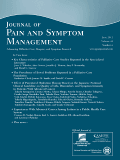
JOURNAL OF PAIN AND SYMPTOM MANAGEMENT
Scope & Guideline
Navigating the Complexities of Pain Management Together
Introduction
Aims and Scopes
- Pain Management Strategies:
The journal emphasizes innovative approaches to pain management, including pharmacological and non-pharmacological interventions, and the integration of these strategies into palliative care. - Symptom Assessment and Management:
Research on the assessment and management of various symptoms associated with serious illnesses, including fatigue, dyspnea, and psychological distress, is a key focus area. - Patient and Family-Centered Care:
Emphasizing the importance of patient and family engagement in care processes, the journal explores ways to enhance communication, shared decision-making, and goal-concordant care. - Culturally Sensitive Approaches:
The journal highlights the significance of cultural competence in palliative care, addressing disparities in access and quality of care among diverse populations. - Education and Training:
There is a strong focus on the education and training of healthcare professionals in palliative care principles, aiming to improve care delivery through enhanced competencies. - Research Methodologies in Palliative Care:
The journal includes studies employing diverse research methodologies, including qualitative, quantitative, and mixed-methods approaches, to address pressing issues in palliative care. - Health Systems and Policy:
Investigating the implications of health policies and systems on the delivery of palliative care services, including barriers to access and the integration of palliative care into broader healthcare frameworks.
Trending and Emerging
- Interdisciplinary Approaches to Care:
There is a significant increase in research focusing on interdisciplinary team-based approaches to palliative care, highlighting the benefits of collaboration among various healthcare disciplines. - Psychosocial and Spiritual Care:
An emerging focus on the psychosocial and spiritual dimensions of care reflects a broader understanding of patient well-being beyond physical symptoms, addressing mental health and spiritual needs. - Technology Integration in Palliative Care:
The incorporation of technology, including telehealth and digital health tools, is gaining momentum as a means to enhance access to palliative care services and improve patient engagement. - Health Equity and Access:
There is a growing emphasis on health equity, with research aimed at understanding and addressing disparities in access to palliative care, particularly among marginalized populations. - Patient-Reported Outcomes and Experience Measures:
An increasing number of studies are focusing on patient-reported outcomes and experience measures to better understand the impact of palliative care interventions on patients' quality of life. - Advance Care Planning Innovations:
Innovations in advance care planning, particularly those that incorporate community engagement and culturally sensitive approaches, are emerging as critical areas of research. - Palliative Care in Non-Traditional Settings:
Research is trending towards exploring palliative care delivery in non-traditional settings, such as emergency departments and community health environments, expanding the reach of palliative care services.
Declining or Waning
- Traditional Pharmacological Approaches:
While pharmacological management of pain remains important, there has been a noticeable decline in articles focusing solely on traditional opioid therapies, as newer multimodal approaches gain traction. - Single-Symptom Focus Studies:
Research that concentrates exclusively on single symptoms, without considering the broader context of patient care, has decreased in favor of more holistic, integrated approaches to symptom management. - Generalized Palliative Care Models:
There is less emphasis on generalized palliative care models, with a shift towards tailored, patient-centered approaches that consider individual patient needs and preferences. - Basic Educational Interventions:
The journal has seen a decline in studies related to basic educational interventions for healthcare providers, as more complex, interdisciplinary training programs become the focus. - Opioid Use in Non-Cancer Populations:
Research specifically addressing opioid use in non-cancer populations has diminished, likely due to the ongoing opioid crisis prompting a reevaluation of pain management strategies.
Similar Journals

SUPPORTIVE CARE IN CANCER
Transforming cancer care with evidence-based insights.SUPPORTIVE CARE IN CANCER is a premier academic journal published by Springer, dedicated to advancing the understanding and management of supportive care for cancer patients. With a notable impact factor, the journal is recognized for its contribution to the fields of Oncology, Rehabilitation, and Nursing, achieving impressive rankings in Scopus, including Q1 for Oncology Nursing and Rehabilitation, and Q2 for general Oncology. Founded in 1993 and looking towards a promising future until 2024, it serves as a vital resource for researchers, professionals, and students engaged in these critical areas of healthcare. Although not an Open Access journal, its rigorous peer-reviewed articles provide valuable insights into innovative practices and evidence-based strategies that enhance patient quality of life during and after treatment. By bridging the gap between research and clinical practice, SUPPORTIVE CARE IN CANCER significantly influences patient outcomes and fosters interdisciplinary collaboration in patient support.
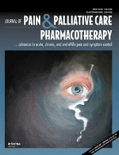
JOURNAL OF PAIN & PALLIATIVE CARE PHARMACOTHERAPY
Navigating the Complexities of Pain Management with Expertise.JOURNAL OF PAIN & PALLIATIVE CARE PHARMACOTHERAPY, published by Taylor & Francis Inc, is a vital resource for professionals in the fields of anesthesiology, pain medicine, and pharmacology. With an ISSN of 1536-0288 and an E-ISSN of 1536-0539, this esteemed journal has been providing a platform for innovative research and critical reviews since its inception in 2002, and it will continue to contribute to scientific discourse until 2024. Holding a Q2 ranking in Anesthesiology and Pain Medicine and a Q3 ranking in Medical Pharmacology, the journal is positioned to deliver high-impact articles that explore advancements in pain management and palliative care strategies. While not an Open Access journal, it offers significant subscription-based access to its curated content, ensuring that researchers and practitioners have the opportunity to stay updated on the latest trends and findings in pain therapy. Furthermore, with its Scopus rankings reflecting ongoing relevance and a robust academic community, this journal is essential for those aiming to deepen their understanding of pain management pharmacotherapy.
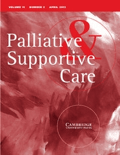
Palliative & Supportive Care
Exploring Innovations in Palliative SupportPalliative & Supportive Care, published by Cambridge University Press, is a pivotal journal dedicated to advancing research and practice in the fields of palliative care, supportive care, and the psychological aspects of terminal and chronic illness. With a robust ISSN of 1478-9515 and an E-ISSN of 1478-9523, this esteemed journal has established itself as a vital resource for professionals, researchers, and students who are committed to improving the quality of life for patients facing serious health challenges. Featuring peer-reviewed articles that span clinical psychology, medicine, nursing, and psychiatry, it holds a respectable impact factor, ranking Q2 in Clinical Psychology, Medicine, and Nursing as per the 2023 category quartiles. The journal is based in the United Kingdom and has been contributing to the field since its inception in 2003. Although it currently does not offer Open Access, its rigorously curated content underscores its relevance and importance in facilitating interdisciplinary dialogue and innovation in palliative and supportive care. For those seeking to stay at the forefront of research, Palliative & Supportive Care remains an indispensable platform for scholarly communication and discovery.

Journal of Osteopathic Medicine
Fostering Global Collaboration in Osteopathic MedicineThe Journal of Osteopathic Medicine, published by Walter de Gruyter GmbH, serves as a significant platform for advancing research and discourse within the realms of complementary and alternative medicine, as well as manual therapy. Since its inception in 2021, the journal has established a solid reputation with a commendable Q2 ranking in the respective categories for 2023, highlighting its impact and relevance in the field. The journal, based in Berlin, Germany, offers an Open Access model, ensuring that both emerging and established researchers have the opportunity to share their findings with a global audience, thereby fostering broader discussions and collaborations. With its commitment to publishing high-quality research, the Journal of Osteopathic Medicine aims to bridge the gap between scientific inquiry and practical application, ultimately enhancing the understanding and treatment approaches within osteopathy and related disciplines. Researchers, professionals, and students alike will find this journal an invaluable resource for staying updated with the latest advancements and methodologies in their field.

Nursing and Midwifery Studies
Advancing nursing and midwifery through open access knowledge.Nursing and Midwifery Studies is an esteemed open-access journal published by Kashan University of Medical Sciences in Iran, dedicated to advancing the fields of nursing and midwifery. Since its inception, it has significantly contributed to the global discourse by disseminating high-quality research and clinical studies pertinent to the profession. With an impressive Q2 ranking in both Advanced and Specialized Nursing and Maternity and Midwifery categories as of 2023, this journal stands out as a vital resource for healthcare professionals, researchers, and students seeking to enhance their knowledge and practice. Its commitment to open access since 2017 ensures that valuable insights are readily available to a wider audience, fostering collaboration and innovation in the healthcare community. As the journal covers diverse topics from clinical practices to policy-making, it plays a crucial role in shaping the future of nursing and midwifery, making it essential reading for anyone involved in these dynamic fields.

Florence Nightingale Journal of Nursing
Empowering the nursing community with open access insights.Florence Nightingale Journal of Nursing is a renowned academic publication dedicated to advancing the field of nursing through rigorous research and scholarly discourse. Published by AVES, the journal operates on an Open Access model since its inception in 1991, ensuring that high-quality research is readily available to all members of the global nursing community. With an ISSN of 2687-6442, it aims to provide a platform for innovative findings and methodologies that enhance nursing practices and education. Despite its rank of #35 out of 45 in the Scopus category for Nursing (miscellaneous), and its position in the 23rd percentile, the journal continues to attract the attention of healthcare professionals, researchers, and students alike, fostering an environment of collaborative learning and evidence-based practice within the nursing discipline. Spanning a converged period from 2020 to 2024, the journal seeks to amplify vital discussions on contemporary challenges and advancements in nursing, contributing significantly to the broader healthcare landscape.
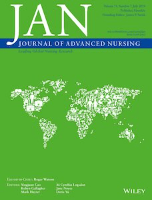
JOURNAL OF ADVANCED NURSING
Fostering excellence in nursing education and practice.JOURNAL OF ADVANCED NURSING is a premier peer-reviewed journal published by Wiley, dedicated to advancing the field of nursing and contributing to the global dialogue surrounding nursing practices and education. With an impressive impact factor, this journal is positioned in the esteemed Q1 category for miscellaneous nursing journals in 2023, reflecting its rigorous standards and the high quality of published research. The journal covers a broad range of topics within nursing, promoting innovative research and critical discourse that informs best practices and policy decisions, making it an invaluable resource for researchers, practitioners, and students alike. With its foundational years dating back to 1976, the JOURNAL OF ADVANCED NURSING continues to uphold a legacy of excellence and impact, currently ranked #7 out of 139 in the Scopus General Nursing category, placing it in the top 95th percentile of nursing journals. Although primarily subscription-based, the journal provides access options that cater to institutions and emerging researchers, ensuring that vital knowledge is disseminated widely within the nursing community.
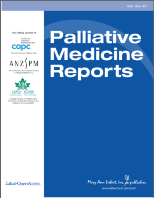
Palliative Medicine Reports
Elevating the standards of palliative care research.Palliative Medicine Reports, published by MARY ANN LIEBERT, INC, is an esteemed Open Access journal dedicated to advancing the field of palliative care and pain management. Since its inception in 2020, this journal has established itself as an important platform for researchers and practitioners in the domains of Advanced and Specialized Nursing, Anesthesiology, and Pain Medicine. With an impressive Q2 ranking in both Advanced and Specialized Nursing and Anesthesiology and Pain Medicine, and a Q3 ranking in the Health (Social Science) category, it stands out as a reputable resource for disseminating high-quality research. The journal fosters an interdisciplinary approach, aiming to bridge gaps in knowledge and practice related to palliative care and the holistic needs of patients experiencing serious illness. Researchers, clinicians, and scholars are encouraged to contribute their work, benefitting from the journal's broad visibility and rigorously peer-reviewed process, ensuring that critical advancements in the field receive the attention they deserve.
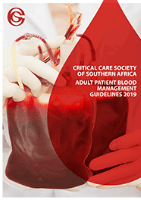
Southern African Journal of Critical Care
Connecting professionals to vital research in critical care.The Southern African Journal of Critical Care, published by the Health & Medical Publishing Group, serves as a pivotal platform for advancing knowledge and practice in the field of critical care and intensive care medicine. With an ISSN of 1562-8264 and an E-ISSN of 2078-676X, this Open Access journal has been making research accessible since 2004, enabling professionals and researchers to share vital findings that shape patient outcomes across Southern Africa and beyond. The journal is recognized in the Q2 category in the 2023 rankings of critical care and intensive care medicine, positioning it among the top-tier publications in the field. With its convergence spanning from 2001 to 2023, the journal continues to uphold rigorous standards and strives to disseminate impactful research as reflected by its Scopus rank of #65 out of 110 and a percentile of 41st. Researchers, clinicians, and students alike will find valuable insights and cutting-edge developments in this essential resource, fostering a community dedicated to improving outcomes in critical care.
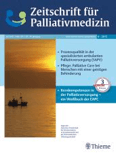
Zeitschrift fur Palliativmedizin
Exploring the frontiers of palliative care with cutting-edge research.Zeitschrift für Palliativmedizin, published by GEORG THIEME VERLAG KG, is a leading journal dedicated to the field of palliative medicine. With its focus on improving the quality of life for patients with severe illnesses, this journal serves as an essential platform for researchers, healthcare professionals, and students interested in the latest developments, practices, and innovations in palliative care. While it does not currently offer open access options, Zeitschrift für Palliativmedizin is committed to disseminating high-quality, peer-reviewed research that advances the understanding and implementation of palliative care strategies. Situated in Stuttgart, Germany, this journal aims to bridge the gap between clinical practice and research, facilitating the exchange of knowledge that enhances patient care and support. As the field continues to grow in importance, this journal stands out as an invaluable resource for those dedicated to improving patient outcomes and advancing the discourse in palliative medicine.